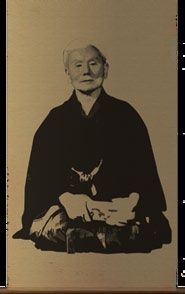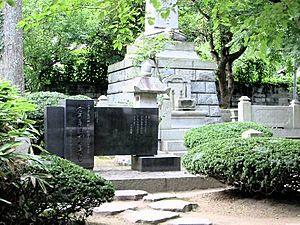Gichin Funakoshi facts for kids
Quick facts for kids Gichin Funakoshi |
|
|---|---|
 |
|
| Born | November 10, 1868 Shuri, Okinawa, Ryukyu Kingdom |
| Died | April 26, 1957 (aged 88) Tokyo, Japan |
| Native name | 船越 義珍 |
| Other names | Funakoshi Gichin (富名腰 義珍), Shōtō (松濤) |
| Style | Shōrei-ryū, Shōrin-ryū, and Shotokan Karate |
| Teacher(s) | Ankō Asato, Ankō Itosu, Matsumura Sōkon, Arakaki Seishō |
| Rank | 5th dan, 10th dan (posthumous) |
| Notable students | Gigō Funakoshi (his son), Hironori Ōtsuka, Isao Obata, Masatoshi Nakayama, Makoto Gima, Shigeru Egami, Tomosaburo Okano, Teruyuki Okazaki, Tetsuhiko Asai, Yasuhiro Konishi, Hidetaka Nishiyama, Tsutomu Ohshima, Taiji Kase, Mitsusuke Harada, Hirokazu Kanazawa, Won Kuk Lee, Masutatsu Oyama, Tetsuji Murakami, Yutaka Yaguchi, Won Kuk Lee, Byung Jik Ro, Choi Hong Hi |
Gichin Funakoshi (船越 義珍, Funakoshi Gichin, November 10, 1868 – April 26, 1957) was a very important person in the world of karate. He founded Shotokan karate-do, which is one of the most popular styles of karate today. Many people call him the "father of modern karate."
Funakoshi learned from great masters like Anko Itosu and Anko Asato. In 1922, he helped bring karate from Okinawa to mainland Japan. He taught karate at many Japanese universities. Later, in 1949, he became the honorary head of the Japan Karate Association.
Early Life and Training
Gichin Funakoshi was born on November 10, 1868, in Shuri, Okinawa. This was the same year as the Meiji Restoration, a big change in Japan. He was born a bit early.
When he was a young boy, he became good friends with the son of Ankō Asato. Asato was a master of karate and another martial art called Jigen-ryū. Soon, Asato became Funakoshi's first karate teacher.
Funakoshi's family had strong traditional beliefs. Because of this, he could not go to medical school, even though he passed the entrance exam. Instead, he became an assistant teacher in Okinawa. He also studied Chinese and Japanese ideas. During this time, he kept learning karate from Ankō Asato, often visiting his home at night for lessons.
What is Shotokan Karate?
Funakoshi trained in two main styles of Okinawan karate: Shōrei-ryū and Shōrin-ryū. The style he created, Shotokan, got its name from his pen name, Shōtō. This name means "waving pines."
The word Kan means a training hall or house. So, Shōtōkan (松濤館) means the "house of Shōtō." Funakoshi's students gave his training hall this name. They put a sign above the entrance where he taught. Besides being a karate master, Funakoshi loved poetry and philosophy. He often went for long walks in the forest to think and write poems.
By the late 1910s, Funakoshi had many students. Some of them were good enough to teach his lessons to others. Funakoshi wanted more people to learn about Okinawan karate. So, he traveled to mainland Japan in 1917 and again in 1922.
In 1922, Funakoshi, who was 53, and his student Makoto Gima, 26, were invited to the Kodokan. This was a famous Judo school. They gave a karate demonstration for Judo Master Jigoro Kano. This demonstration helped make karate very popular in Japan.
In 1930, Funakoshi started a group called Dai-Nihon Karate-do Kenkyukai. This group helped people who studied karate-dō share ideas. In 1936, the group changed its name to Dai-Nippon Karate-do Shoto-kai. Today, this group is known as Shotokai. It helps keep Funakoshi's karate teachings alive.
In 1936, Funakoshi built the first Shōtōkan dojo (training hall) in Tokyo. While in Japan, he changed the meaning of the word "karate." Before, it meant "China hand" (唐手). He changed it to mean "empty hand" (空手). This was to show that karate was not just from Chinese boxing, even though it borrowed some ideas. Funakoshi also said that "empty" fit because it meant a way of fighting that didn't rely on weapons.
Changing the meaning of kara caused some disagreement with traditionalists in Okinawa. Because of this, Funakoshi stayed in Tokyo. In 1949, his students created the Japan Karate Association (JKA). Funakoshi was the honorary head. However, Masatoshi Nakayama mostly led the group. The JKA helped organize and teach Funakoshi's lessons.
Later Life and Legacy
Gichin Funakoshi developed a joint condition called osteoarthritis in 1948. He passed away on April 26, 1957.
Funakoshi wrote several books about karate. One of them was his life story, called Karate-Do: My Way of Life. But his most important legacy is a set of ideas for karate training. These are called the niju kun, or "twenty principles." These 20 rules guide all Shotokan students. They are published in a book called The Twenty Guiding Principles of Karate. In this book, Funakoshi explains how students can use these rules to "become better human beings." His book Karate-Do Kyohan: The Master Text is his most detailed work. It covers karate history, basic moves, kata (forms), and kumite (sparring). The famous Shotokan Tiger drawing by Hoan is on its cover.
Memorial
A special memorial for Gichin Funakoshi was built by the Shotokai group. It is at Engaku-ji, a temple in Kamakura. It was put up on December 1, 1968. Kenji Ogata designed it. The monument has writing by Funakoshi and Sōgen Asahina. It says, Karate ni sente nashi, which means "There is no first attack in karate." This is one of Funakoshi's Twenty Principles. Next to this saying is a copy of a poem he wrote in 1922, when he was traveling to Japan.
See also
 In Spanish: Gichin Funakoshi para niños
In Spanish: Gichin Funakoshi para niños
- List of Shotokan organizations


